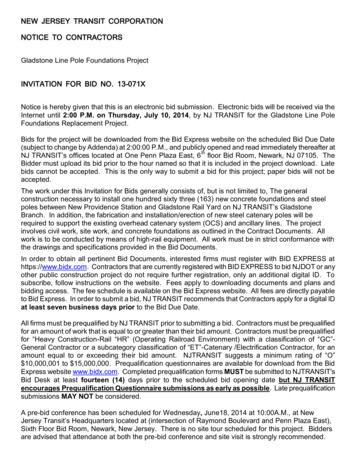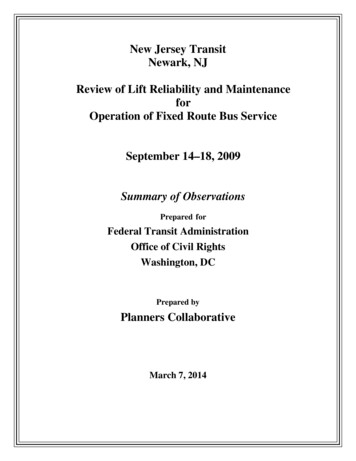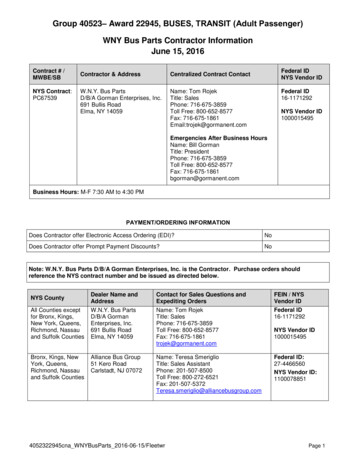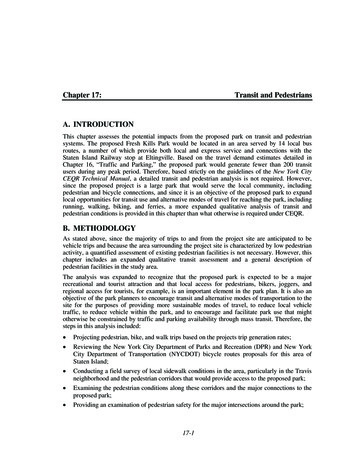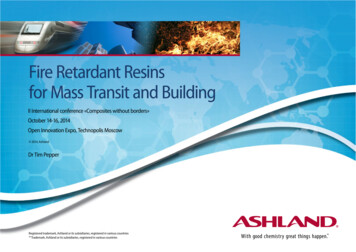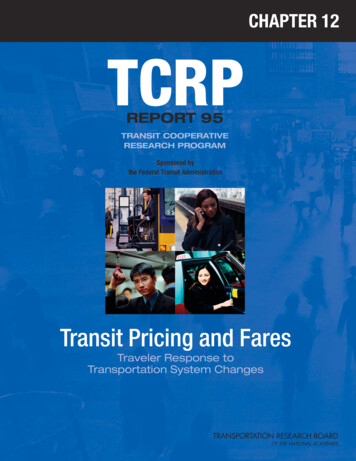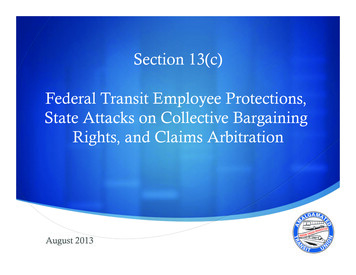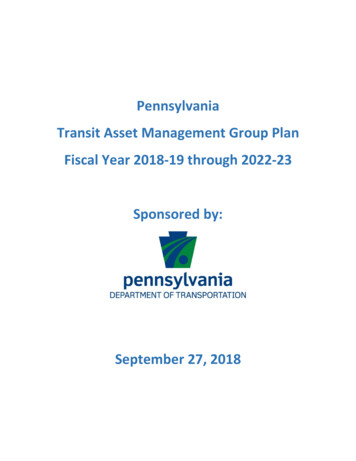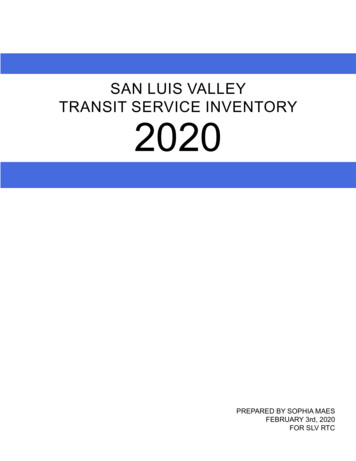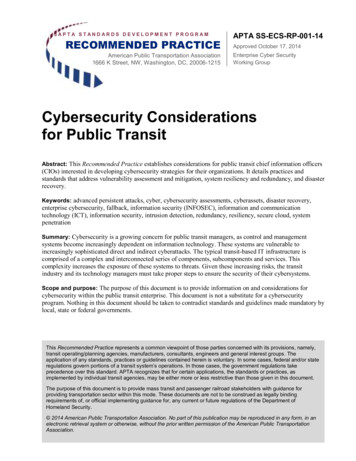
Transcription
3APTA STANDARDS DEVELOPMENT PROGRAMRECOMMENDED PRACTICEAmerican Public Transportation Association1666 K Street, NW, Washington, DC, 20006-1215APTA SS-ECS-RP-001-14Approved October 17, 2014Enterprise Cyber SecurityWorking GroupCybersecurity Considerationsfor Public TransitAbstract: This Recommended Practice establishes considerations for public transit chief information officers(CIOs) interested in developing cybersecurity strategies for their organizations. It details practices andstandards that address vulnerability assessment and mitigation, system resiliency and redundancy, and disasterrecovery.Keywords: advanced persistent attacks, cyber, cybersecurity assessments, cyberassets, disaster recovery,enterprise cybersecurity, fallback, information security (INFOSEC), information and communicationtechnology (ICT), information security, intrusion detection, redundancy, resiliency, secure cloud, systempenetrationSummary: Cybersecurity is a growing concern for public transit managers, as control and managementsystems become increasingly dependent on information technology. These systems are vulnerable toincreasingly sophisticated direct and indirect cyberattacks. The typical transit-based IT infrastructure iscomprised of a complex and interconnected series of components, subcomponents and services. Thiscomplexity increases the exposure of these systems to threats. Given these increasing risks, the transitindustry and its technology managers must take proper steps to ensure the security of their cybersystems.Scope and purpose: The purpose of this document is to provide information on and considerations forcybersecurity within the public transit enterprise. This document is not a substitute for a cybersecurityprogram. Nothing in this document should be taken to contradict standards and guidelines made mandatory bylocal, state or federal governments.This Recommended Practice represents a common viewpoint of those parties concerned with its provisions, namely,transit operating/planning agencies, manufacturers, consultants, engineers and general interest groups. Theapplication of any standards, practices or guidelines contained herein is voluntary. In some cases, federal and/or stateregulations govern portions of a transit system’s operations. In those cases, the government regulations takeprecedence over this standard. APTA recognizes that for certain applications, the standards or practices, asimplemented by individual transit agencies, may be either more or less restrictive than those given in this document.The purpose of this document is to provide mass transit and passenger railroad stakeholders with guidance forproviding transportation sector within this mode. These documents are not to be construed as legally bindingrequirements of, or official implementing guidance for, any current or future regulations of the Department ofHomeland Security. 2014 American Public Transportation Association. No part of this publication may be reproduced in any form, in anelectronic retrieval system or otherwise, without the prior written permission of the American Public TransportationAssociation.
Contents1. Overview . 11.1 National cybersecurity strategy . 11.2 Transportation systems sector cybersecurity strategy. 2ParticipantsThe American Public TransportationAssociation greatly appreciates thecontributions of the EnterpriseCyber Security Working Group,which provided the primary effort inthe drafting of this RecommendedPractice.At the time this standard wascompleted, the working groupincluded the following members:2. Cyberthreat landscape . 22.1 Target . 22.2 Threats . 43. Transportation information ecosystem . 53.1 Operational systems . 53.2 Enterprise information system . 53.3 Subscribed system . 64. Pillars of cybersecurity . 6Lurae StewartMichael BoscheTheodore LawrenceGary FosterBrad BakerAida AsuncionMichael DePalloLee AllenBarry EinsigSean RyanDave GorshkovDavid HahnDoug HawkinsJohn HoganLisa KaiserJoseph KellyJohn PlanteJosh PosterSean RyanHarry SaportaDave TeumimJohn WalshDerrick WigglesworthBridget ZamperiniJohn Zukosky4.1 Governance . 74.2 IT infrastructure . 74.3 Operations . 84.4 People . 94.5 Facilities. 95. Managing information security risk. 105.1 Integration requirements . 116. System contingency and resiliency . 126.1 Types of plans . 127. System and service acquisition . 137.1 System Development Life Cycle . 147.2 Information security services and products . 158. Standards, resources and tools. 158.1 National Institute of Standards and Technology (NIST) . 158.2 National Initiative for Cybersecurity Education (NICE) . 168.3 International Organization for Standardization (ISO) . 168.4 APTA cyberstandards . 168.5 Federal Information Security Management Act (FISMA). 178.6 U.S. Computer Emergency Response Team (US-CERT) . 178.7 Federal Information Processing Standard (FIPS) . 178.8 SANS Institute . 17References . 19Definitions . 21Abbreviations and acronyms . 21 2014 American Public Transportation Association ii
APTA SS-ECS-RP-001-14 Cybersecurity Considerations for Public TransitCybersecurity Considerations for Public Transit1. OverviewCybersecurity is a growing concern that all transit agencies from large to small must recognize and takeappropriate actions on. With the unprecedented pace and complexity of cyberattacks, a transit agency must beproactive and adopt a holistic approach at the strategic level to protect its organization’s critical informationand fulfill its obligation to its customers. Cybervulnerabilities are exploited not only directly by means ofinformation technology (IT), but the threat also has grown to a level of sophistication in which socialengineering has been leveraged to exploit individuals. A transit agency’s cybersecurity strategy must betightly woven into the fabric of the organization at all levels. While eliminating cyberthreats is impossible,transit agencies must take a full-spectrum risk-based approach. No longer is cybersecurity an IT departmentproblem. It has manifested to become a critical management issue that requires some aspect of involvement atthe highest level.The American Public Transportation Association has developed several working groups to address the seriousconcern of cybersecurity. The mandate of these working groups is to produce guidance in maintainingadequate cybersecurity that all transit agencies, large or small, can utilize and implement. This document is aheadway into a family of specific cybersecurity related Recommended Practices. This document specificallyis meant to provide transit agencies an overview of cybersecurity considerations. Other RecommendedPractices that transit agencies can adopt and tailor for their immediate use are linked and referencedthroughout.1.1 National cybersecurity strategyThe dependence on and seamless integration of technology into everyday activities and operations hasexposed and brought to the forefront the critical need to address cybersecurity. APTA understands the realcyberthreats against transit infrastructure and agencies across the nation. Cyberthreats have become such animportant and sensitive concern that the current administration has identified cybersecurity as an importantpriority. The administration’s cybersecurity strategy is twofold: Improve resilience to cyber-incidents by hardening digital infrastructure to be more resistant topenetration and disruption; improving the ability to defend against sophisticated and agilecyberthreats; and recovering quickly from incidents, whether caused by malicious activity, accidentor natural disaster.Reduce the cyberthreat through working with allies on international norms of acceptable behaviorin cyberspace, strengthening law enforcement capabilities against cybercrime and deterring potentialadversaries from taking advantage of remaining vulnerabilities.To support and achieve the goals of the nation’s cybersecurity strategy, and aligning with the Department ofHomeland Security (DHS), the Department of Transportation (DOT) and the Transportation SecurityAdministration (TSA), APTA has broadly identified the following priorities for transit agencies to considerand at the minimum address with respect to an agency’s information and communication technology (ICT)infrastructure. The four priorities represent a broad-based, balanced information security program that 2014 American Public Transportation Association1
APTA SS-ECS-RP-001-14 Cybersecurity Considerations for Public Transitaddresses the management, operational and technical aspects of protecting federal information andinformation systems:1. Standards, policies and procedures: Transit agencies should develop, formalize and documentthorough standards, policies and procedures in protecting against cyberthreats and improvingresilience to such incidents.2. Information system technology and infrastructure: Transit agencies should ensure the capability,maintenance, serviceability and interoperability of the organization’s ICT infrastructure. Transitagencies should implement a thorough system development life cycle (SDLC) process that integratesrisk management into the process.3. Awareness, training and education: Transit agencies should focus on developing a general cultureof awareness on cybersecurity. Further, transit agencies should identify specific individuals necessaryto receive further training and education as part of their professional development and careerprogression, to enhance the organization’s internal capabilities against cyberthreats.4. Information security risk management integration: Transit agencies should integrate informationsecurity into the organization’s risk management strategy from the very top to align with theorganization’s strategy, mission and goals. Integrating information security into the risk managementprocess will ensure proper identification and allocation of essential resources in enhancing theorganization’s ability to mitigate increase resiliency against cyberattacks.1.2 Transportation systems sector cybersecurity strategyOur national security depends on an open, reliable and secure transportation system. The sector’scyberinfrastructure, which includes both business systems and physical automation systems, plays a criticalrole, as it enables increasingly complex and technologically sophisticated transportation operations. Thesector’s cybersystems and physical automations require protection against malicious and inadvertentmanipulation. Due to the numerous interdependencies within the sector, failure to protect these systems andautomations may result in significant and adverse business, safety and security implications throughout thesector. By maintaining continuous cybersecurity awareness, improving and expanding voluntary participation,defining the conceptual environment, enhancing intelligence and security information sharing, and ensuringsustained coordination and strategic implementation, transit agencies should be able to deter significantthreats and to help protect their systems.2. Cyberthreat landscape2.1 TargetWith the growing dependence on information and communication technology by governments, business,individuals and the networks linking to the end users, cyberspace is increasingly becoming an attractivetarget. An effective cyberattack against a transportation agency will seek to compromise the confidentiality,availability and/or integrity (see Figure 1) of the agency’s information by of exploiting the enterprise’s ICTsystem: Confidentiality: Preserving authorized restrictions on information access and disclosure, includingmeans for protecting personal privacy and proprietary information. A loss of confidentiality is theunauthorized disclosure of information. 2014 American Public Transportation Association2
APTA SS-ECS-RP-001-14 Cybersecurity Considerations for Public Transit Availability: Ensuring timely and reliable access to, and use of,information. A loss of availability is the disruption of access to oruse of information or an information system.Integrity: Guarding against improper information modification ordestruction; this includes ensuring information non-repudiation andauthenticity. A loss of integrity is the unauthorized modification ordestruction of information.FIGURE 1Information Security DiagramModern transit systems are heavily dependent on a variety of informationtechnology systems and therefore are naturally “at risk” to a wide spectrumof cyberthreats. Cyberattacks can destroy a transit agency’s physicalsystems, render them inoperable, hand over control of those systems to anoutside entity or jeopardize the privacy of employee or customer data.Cyberattacks threaten every aspect of modern life that is touched—indirectly or directly—by information technology.Typically, a transportation agency’s IT infrastructure consists of three general layers (see Figure 2):operational systems, enterprise information systems and subscribed systems. These layers are integrated andimplicitly dependent on one another for seamless operations. Each layer is critical to the operational integrityof the transit agency and—for the purposes of this Recommended Practice—will be referred to as thetransportation information ecosystem (TI ecosystem), as a whole. Systems within the TI ecosystem may shareor depend upon data stored and processed within other layers.FIGURE 2Transportation Information EcosystemCyberattacks may exploit and target specific system layers within the transit agency, including but not limitedto the following: Operational systems: These systems integrate supervisory control and data acquisition (SCADA),original equipment manufacturer (OEM) and other critical component technologies responsible forthe control, movement and monitoring of transportation equipment and services (i.e., train, track andsignal control). Often such systems are interrelated into multimodal systems such as buses, ferries andmetro modes.Enterprise information systems. This describes the transit agency’s information system, whichconsist of integrated layers of the operating system, applications system and business system.Holistically, enterprise information systems encompass the entire range of internal and externalinformation exchange and management. 2014 American Public Transportation Association3
APTA SS-ECS-RP-001-14 Cybersecurity Considerations for Public Transit Subscribed systems: These consist of “managed” systems outside the transportation agency. Suchsystems may include Internet service providers (ISPs), hosted networks, the agency website, datastorage, cloud services, etc.2.2 ThreatsCyberspace is a unique ambiguous environment that easily allows governments, criminals, terrorists and evenmischievous juveniles to mask their identity and remain anonymous. Cyberattacks directed againsttransportation organizations can be conducted in many forms, which may consist of a single act or acombination of discrete steps threaded together. Such acts may be a complicated exploitation of coding or thesimple use of social engineering—an art of manipulating individual’s trust, behavior or identity—to reveal orto gain access to confidential information. Once the targeted system is compromised, perpetrators mightimplement “back door” gates or install stealth code allowing information to be monitored or removed withoutdetection. “Zero day” switches can be implemented, which can be activated at a specified time or under aspecified set of conditions, turning control of the operational or business systems over to the perpetrator.Furthermore, cyberthreats may not all be software attacks. While cyberattacks in the form of softwaremanipulation require a degree of expertise and technical knowledge, physical manipulation (intentional andunintentional) of the system is of real concern as well. Many attacks are known to exploit specific hardwarelinked to the TI ecosystem. Such examples may include manipulation of infrared (IR) or laser signalingdevices, jamming Wi-Fi signals or even physical tapping or damaging critical communication cabling ornodes.Successful cyberattacks rarely take the same form in consecutive or follow-on assaults against a targetedsystem. The cyberenvironment is in its fastest form of evolution, with exponential advancements oftechnology and information sharing. Due to the “arms race” culture that exists in the initiating elements(criminal organizations, state actors, activists or “hacktivists”) and the mitigating or responding elements(government, industry and law enforcement), attacks are adapted in response to the level of success or failurewith which they impact a target organization. Cyberattacks that are detected are usually contained and/ormitigated through some form of countermeasure or response. These countermeasures force the initiatingelements to evolve their attack in order to circumvent the countermeasures. Many of the most threateningcyberattacks are now designed to hide in the system and evade detection, quarantine and/or removal; bygaining control of the software that is implemented to capture the malicious software (called malware) in thefirst place. Additionally, such sophisticated malware is capable of regular self-updates, prolongingsurvivability and preventing detection. (e.g., Stuxnet).While many cyberattacks may be external, transit agencies, just like any other organization, are susceptible toattacks from internal sources, such as a disgruntled employee. An attack from an internal source has a higherprobability of success and a greater potential for damage, given the level of access and knowledge an insidermay possess. Employees with minimal constraints or supervision can cause significant damage and pose aserious threat to a transit agency.Cyberthreats and vulnerabilities of critical components of the transportation information ecosystem not onlyput the transit agency and the lives of passengers at risk but may also put the agency in noncompliance withmany legal requirements, such as the Health I
The American Public Transportation Association has developed several working groups to address the serious concern of cybersecurity. The mandate of these working groups is to produce guidance in maintaining adequate cybersecurity that all transit agencies, larg

